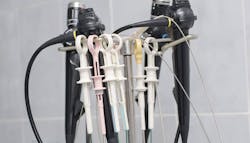Alternative options to reusable endoscopes simmering
From a reprocessing perspective, Sterile Processing & Distribution (SPD) experts anticipate minimally invasive surgery migration to hybrid rigid and flexible endoscopes by the mid-2030s but the expected shift seems to be simmering to a slow boil.
Generally, healthcare organizations can choose between three types of flexible and rigid endoscopes – those that are completely reusable, those that are completely disposable/single-use only and those that are called “hybrid” for infection control purposes because they are reusable devices with a select number of disposable components that can be discarded after use (e.g., distal covers and adaptors, etc.).
By and large, two primary issues sparked the emergence of disposable and hybrid models as alternatives to the traditional reusable endoscopes that surgeons have operated since the 1980s: The challenges and difficulties in thoroughly cleaning, disinfecting and sterilizing these increasingly intricate and complex devices and the number of healthcare-associated infections attributed to inadequately reprocessed devices, such as bronchoscopes.
Early countermeasures called for more education and training of SPD technicians handling these delicate and expensive instruments, followed by demands for more detailed, but clearly organized and easily understandable instructions for use (IFUs) from the device manufacturers. Within the last decade, however, the third option of changing the devices themselves emerged as a possibility.
Several years ago, Healthcare Purchasing News began exploring and reporting on the potential shift that generated buzz and quick momentum with radical predictions of a progressive shift in behaviors and habits, but as time progressed, topped by a global pandemic, the early full-speed-ahead approach seems to have settled into a steady, but surefire gait.
Once again, HPN reached out to a small group of executives at manufacturers of endoscope devices and related reprocessing supplies and equipment about their changing forecast of any market shifts through 2035. They were able to choose from among five different potential market scenarios and to share their reasoning.
1. Fully reusable endoscopes will remain. Healthcare organizations will continue to rely on fully reusable flexible and rigid endoscopes for the majority of minimally invasive surgical (MIS) procedures
2. Hybrid models will become a minority segment. Healthcare organizations will increasingly shift toward using hybrid flexible and rigid endoscopes that incorporate disposable components that can be discarded after use, but the hybrid models WILL NOT surpass the use of fully reusable models
3. Hybrid models will become the majority. Healthcare organizations will increasingly shift toward using hybrid flexible and rigid endoscopes that incorporate disposable components that can be discarded after use, and the hybrid models WILL surpass the use of fully reusable models
4. Disposable/single-use only models will become a minority segment. Healthcare organizations will increasingly shift toward using fully disposable flexible and rigid endoscopes, but the disposable models WILL NOT surpass the use of fully reusable models
5. Disposable/single-use only models will become the majority. Healthcare organizations will increasingly shift toward using fully disposable flexible and rigid endoscopes, and the disposable models WILL surpass the use of fully reusable models
Last year, Nos. 1 and 5 didn’t generate support as executives felt remaining with fully reusable models – essentially, the status quo – wasn’t an option and neither was complete conversion to disposable/SUDs. This year, opinions and predictions seems to have shifted and tempered a bit, retreating to a wait-and-see area on one hand to a gradual acceptance and adoption of hybrids as part of conventional practice.
Olympus Corporation of the Americas, one of the world’s leading manufacturers of endoscope products and technology embraces the practical approach because none of the options cited adequately addresses what they feel is the issue.
“All hospitals are concerned about sustainability and reducing hospital waste,” noted Richard Radford, CEO, Cenorin LLC. “By reducing single patient use medical devices, hospitals will reduce their waste stream and help achieve their sustainability goals.”
“Medical waste disposal is a significant issue and costly,” he said. “With 75 million endoscopy procedures performed annually, think of the cost to the environment from this mountain of waste. OEMs should focus their efforts on developing more robust endoscopes, ones that can be fully sterilized by low cost low environmental impact methods.”
The switch is on
Others see that the migration – albeit partial and slow – already is underway as hybrid models are being incorporated for select uses, but that ultimately, reusable models will prevail as the preference among the majority.
“We need to consider here all the clinical locations where endoscopes are clinically used,” Whelan continued. “Generally speaking, a larger health system may be able to afford and support an all-disposable inventory, but less so a standalone endoscopy center or clinic. Technology needs to catch up – beyond what already exists. It is good to have disposable options, but we also look forward to reusable endoscopes that can be routinely more effectively processed. That requires material changes for the endoscopes themselves and/or automated cleaning and disinfection/sterilization options that are currently in R&D stages of development.”
“Although patients will be looking for healthcare to use more disposable scopes or scopes with more disposable components, I don’t think we are there yet with disposable scopes,” she asserted. Still, she acknowledges a radical shift could occur “if the quality and cost enable their use.
“Disposable would completely eliminate the possibility of cross-contamination, providing piece of mind for the patient and the healthcare institution,” Ward-Fore added.
“The use of more hybrid models seems likely as there continues to be lapses in reprocessing and outbreaks of antibiotic resistant infections related to endoscopes,” Gusanders told HPN. “I imagine low-volume facilities will continue to use mostly reusable models by 2035, with larger facilities seeing more hybrid models than fully reusable. The demands on reprocessing environments (e.g., decontamination sinks, AERs, storage) will be fascinating to see with the increased of hybrid models.”
Continue reading …
AAMI redefines, revamps sterile processing practices via ST91
Who owns pre-treatment at point-of-use
Disposables/single-use devices vs. hybrids – which leads by 2035?
Strategies, tactics for high-quality endoscope reprocessing
Forget about using SUDs; what if you no longer could make them?
How might ‘right to repair’ regs impact healthcare?
How to approach patient safety gap with flexible endoscopes
About the Author
Rick Dana Barlow
Senior Editor
Rick Dana Barlow is Senior Editor for Healthcare Purchasing News, an Endeavor Business Media publication. He can be reached at [email protected].







